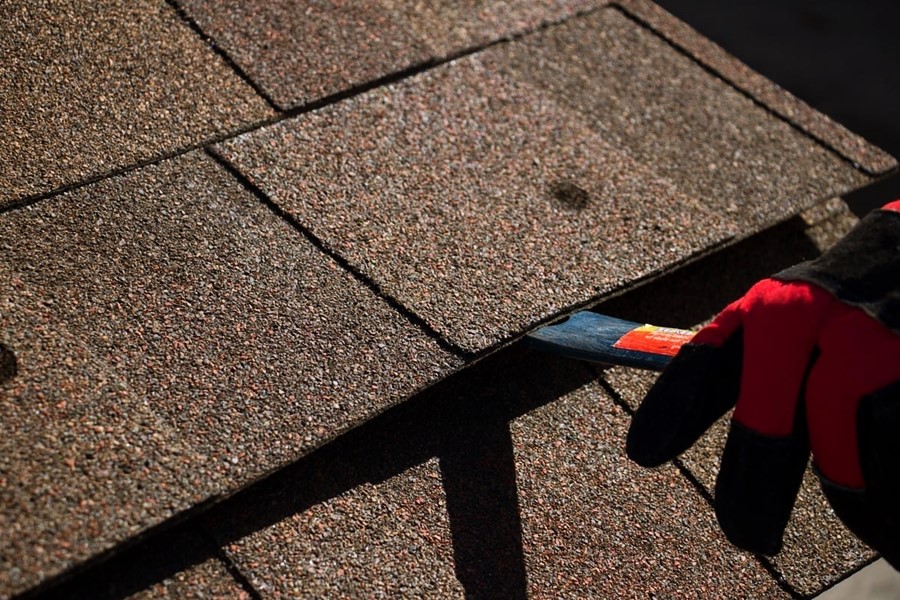Shingles are the most common type of roofing material, but they can be destroyed by wind and water damage or by insects. If your shingles are damaged and need to be replaced, you’ll have to repair them first. Repairing a damaged shingle takes time and effort, but it’s not difficult if you follow these steps carefully:
Table of Contents
What You’ll Need
- Hammer
- Utility knife: You’ll need a sharp utility knife to cut the shingle. A dull blade will make it more difficult to cut and may cause you to slip and cut yourself, so be sure yours is in good shape before you begin.
- Roofing cement: This is used to seal the bottom of a new shingle down over any existing nails that remain in your roof after removing an old one. It also helps prevent leaks from developing between the old and new pieces of shingles. While there are products on the market that can be applied without mixing, we recommend using a premixed product instead; otherwise, you might end up accidentally mixing too much or too little water into your mixture and causing problems with your repair job down the road. Make sure that whichever brand or type of roofing cement you choose has a label stating “for use with asphalt shingles.” Otherwise, it won’t work properly on your house’s plywood sheathing (the base layer of wood where shingles are installed).
Step 1: Remove the damaged shingle.
- Use a hammer and chisel to remove the damaged shingle. You can also use a utility knife if you can’t get close enough to the nails with your chisel.
- Remove any nails left in place after removing the shingle by using pliers or another tool that will grab them effectively.
Step 2: Replace any loose nails.
Remove any loose nails. Use a hammer and nail set to secure them (make sure you’re using the right size of nail for the shingle). Test the shingle by tapping it with your hand. If it’s still loose, repeat step 2.
Step 3: Install and secure the replacement shingle.
Once you’ve determined the best location for your replacement shingle, use a hammer to secure it in place. While you should always be careful when handling any power tools, be especially careful when working with a hammer on your roof. It’s easy to slip and fall off of even an average-sized roof, so make sure that you have good footing before attempting this step.
Once the shingle is secured with nails, it’s time to set them below the surface of the shingle using a nail set (or “nail punch” as they are sometimes called). This tool will sink each nail below its head so that it doesn’t stick out at all—this ensures that wind won’t catch on these protruding nails and rip them off later in life. Then use a roofing square or other straightedge device to ensure that both sides of this new shingle are properly aligned with their neighbors before moving on to step four!
Step 4: Seal around the new shingle with roofing cement.
Once the shingle has been set into place, you’ll need to seal around it with roofing cement.
To apply the cement, use a putty knife or paintbrush to spread the material along the top of both sides of the shingle and across its surface. If you’re using a notched trowel, simply dip it in water and run it along all four edges of your new shingle until they’re flat.

Bonus Tips
- Make sure you have the right tools. You won’t need a lot of fancy stuff, but having the right tools at your disposal will make your life a lot easier.
- Don’t forget your gloves and shoes! It’s a good idea to wear working gloves so that you don’t get splinters or blisters in your hands and feet when working on the roof with pieces of shingle flying off into space. You’ll also want to wear sturdy shoes that can handle being up on top of a slippery surface, especially if it rains (and it will).
- Have an escape plan in case it rains while you’re doing repairs! There are two main options here: either go down first, then come up after things dry out from underneath; or just stay inside where it’s safe until everything dries out again before going outside again later on in life
Repairing roof shingles is a potentially dangerous job, so make sure you’re prepared for it and follow instructions carefully before starting the project.
Repairing roof shingles is a potentially dangerous job, so make sure you’re prepared for it and follow instructions carefully before starting the project.
- Wear protective gear such as goggles and gloves to keep from getting splinters in your eyes or being cut by sharp objects.
- Use safety equipment, such as a ladder, when working on high areas like roofs.
- Make sure you have the right tools for the job at hand: For example, if you’re repairing cracked shingles on a flat surface, purchase a hammer; if repairing cracked shingles on an angled surface (i.e., hip), purchase an ice pick with rounded ends so that it doesn’t damage any other pieces of shingle beneath it.* Read all instructions before starting work so that you know how many boards need replacing or fixing based on their condition.* Make sure there’s enough time available in your schedule so that repairs can be completed without rushing through them!
Repair Roof Shingles Results
We hope you found this guide helpful and that it has given you the confidence to tackle your own roofing problems without paying someone else. While repairing shingles can be a bit of work, it’s something anyone can do with a little time and patience.

I come from an extensive family of construction professionals and have been around it most of my life. Early in my home renovation career, I remodeled several homes as well as built custom homes and additions.
Although this was a great experience, I decided to specialize in roofing and gutter systems because I enjoy interacting with customers and seeing their satisfaction when the job is done.

